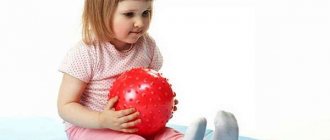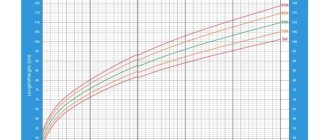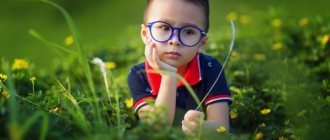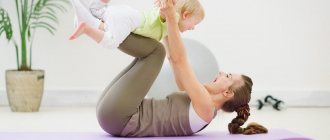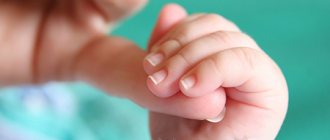- A set of exercises for children aged 7 months.
- Massage exercises for children at 7 months.
A set of exercises for children aged 7 months includes several gymnastic and several play techniques. It should be understood that you can only encourage your baby to do something at this age by getting him interested - alternate exercises for 7-month-olds with games and don’t forget to chat with your baby, praising his successes. A positive attitude is the best help in this matter!
A set of exercises for children aged 7 months
The set of exercises for 7-month-old children includes both old, familiar elements and new ones. It's time to complicate the old ones - otherwise the baby will simply not be interested in studying.
"Boxing" with rings
Surely you have already mastered the alternating flexion and extension of your arms, the so-called “boxing”, but before that you securely fixed the baby’s wrists with your palms. With a 7-month-old baby, you can already use plastic or wooden rings. Place them in the baby’s palms and, after waiting for a firm grip, pull them to the sides until the elbow joints are completely straightened. After this, return your hands to the starting position.
Circular movements with legs
With your child lying on his back, support his legs with your palms. Bringing your knees to your stomach, begin circular movements - to the sides, straighten, bring together and bend again, pressing it to your tummy. Make sure to do everything carefully, without pressure. Please note that if your baby experiences discomfort, you should consult a specialist to rule out hip dysplasia.
Rollover from back to tummy
This kind of exercise is not new for a 7-month-old child, however, it becomes more difficult over time. Initially, you held both of the baby’s hands with your hands, then you held the hand with one, and the knees with the other. Now is the time to give the child more independence - hold the child’s hand with one hand, and leave the other for safety.
Alternate and simultaneous flexion and extension of the legs
The already known “sliding steps” and simple bending and extension of the legs are important elements of the complex of exercises for children of 7 months. They develop leg muscles and joints, strengthening them. Children who are physically healthy and strong are much more likely to avoid the fear of walking on their own.
Crawling for a toy
In the past months, you have been actively preparing your baby for the fact that very soon he will be able to crawl - this moment for many comes precisely at the 7th month of life. To encourage your baby to move around, “lure” him by placing attention-grabbing toys slightly out of reach. Push him, providing support for his heels and make sure that the baby is interested.
Taking out a toy
You can end your workout with a game exercise. Let the baby, from a sitting position, reach for the toy with which you beckon him. Since the toy is in your hands, you can control the process yourself, but do not forget to please your baby with achieving the goal. Exercises should bring not only benefits, but also pleasure!
What is dynamic gymnastics for newborns?
Dynamic gymnastics are simple exercises aimed at stimulating the functioning of the vestibular system in an infant. This is real art: by doing exercises in various combinations, each time you create a new, your own drawing, the authors of which are the parents and the baby. Life during infancy becomes richer, more active, more interesting, because the child does not lie down all day long, but moves, flies, and turns over.
Benefits and contraindications
Gymnastics classes are useful and enjoyable, the child communicates with his parents, gets to know each other closely, because the connection between them comes to the fore. A look, a gentle smile and the touch of mom and dad's hands convey a state of confidence to the baby.
Moreover, gymnastics for newborns brings many benefits:
- warm-up and massage preceding classes have a beneficial effect on the child’s body;
- air baths strengthen the baby’s immunity;
- subtle contact contributes to the child’s calm;
- dynamic exercises have a positive effect on the respiratory system, blood circulation, and vestibular apparatus.
Contraindications to gymnastics from the first days of life are:
- increased intracranial pressure;
- uncompensated heart disease;
- genetic joint diseases;
- disorders in the musculoskeletal system in a child;
- hypertonicity;
- late start of classes (after 6 months).
When can I start classes?
Expert advice on the age at which you can do dynamic gymnastics varies. Some say that the earlier you start systematic exercises, the better, that is, a week after birth. They explain their opinion as follows: if you start exercising later, the baby’s ligaments will get stronger and it will be harder to stretch them. The baby grows, the weight increases, as a result of which the load on the body becomes greater.
Others believe that it is necessary to do dynamic gymnastics from the age of 3 weeks, since during this period the baby is already recovering from the stress of birth and adapting to the world around him.
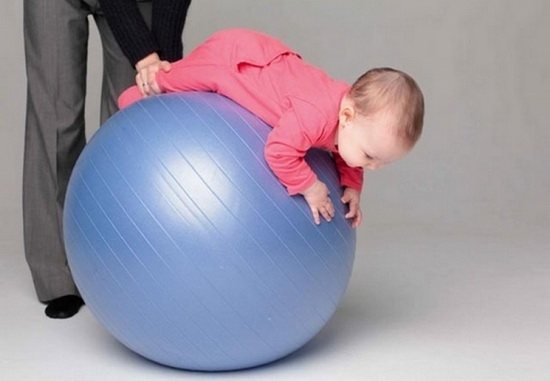
Before you start classes, you need to take note of several rules for conducting them:
- classes are conducted in a cool, ventilated room, or outdoors;
- class time is the first half of the day when the child is awake;
- exercises are carried out before meals or an hour after it;
- gymnastics should be like a ritual: it needs to be done at the same time and every day, because the baby’s memory is programmed for two days, and if you miss classes, the baby’s body may forget about them;
- You should definitely consult with specialists;
- all exercises must be done smoothly, carefully, without jerking;
- Each exercise takes 1-2 weeks.
Massage exercises for children at 7 months
No less attention should be paid to massage. Since the baby is not walking yet, it is necessary to work specifically with his feet - their underdevelopment and deformation is a serious problem, forcing all shoes to be equipped with orthopedic insoles (a good selection of orthopedic insoles is here - https://www.reaclinic.ru/service/ortostelki/) . To prevent flat feet and form a correct foot, it is important to stretch the leg, tickle it, encouraging the baby to independently bend and straighten his toes.
Of course, since the baby has learned to roll over, sit and crawl, he is already actively developing his muscles on his own, but massage is not only a benefit, but also an opportunity to avoid tactile hunger in a child. Besides, it’s so nice to give pleasure to your beloved baby!
Child development in the first month: Special exercises
At the age of ten days, the child can already communicate with the outside world. Relying not only on reflexes, but also on your sensors. Most children at this age can freely hold in their field of vision an object that moves, for example, a bright rattle (about 10 centimeters in size). By placing it at the level of the child’s chest, who lies on the child’s back, and moving it left and right, the baby will fix the toy with his gaze. This focusing of the gaze will last for several seconds.
Content:
- Lesson on visual perception
- Hold your head correctly
- An activity to test your baby's hearing activity
- An activity that helps develop psychomotor skills
Subsequently, the baby’s indicative visual reactions become much more developed. At three weeks of age, he can fix with his gaze non-moving objects of different sizes.
At the end of the first month, the baby can follow visually. For example, if you repeat the manipulations with a bright toy, you will see how the child fixes the toy with his gaze and even follows it with his eyes.
At the age of one month, the baby can independently lift and hold his head if he is placed on his stomach on a flat surface. Some children manage to hold their head up for several tens of seconds.
Exercises that are aimed at the intellectual development of the child.
- Place your baby on his stomach in a prone position. Place your hand on the toddler's chin, and with the other hand touch the soles of his feet. In response to these actions, the baby will push off with his legs and move forward.
- Also place the baby on his stomach. Place one hand under the toddler's chin, and the other under the belly, and carefully pull the baby forward. He will make crawling movements.
- Place the baby in an upright position. It is necessary to hold the baby suspended by the hips, so as to maintain balance and not upset the balance. The baby will try to hold his head and torso upright on his own.
- Place the child on his back, take him by the hands and gently pull him towards you. At the same time, the baby will try to pull himself forward with his hands.
- You need to grab the baby's belly and hold it face down. The baby should raise his head.
- In the same way, hold the baby in weight, only in an inclined-lateral position (while grasping the right and left sides in turn). The child will straighten his legs and raise his head.
- Place the baby on a support in a vertical position. In response to this, the child will straighten his torso and legs and raise his head. If you pull slightly forward, the baby will make a stepping movement.
Any of these exercises must be repeated for three to four minutes, while patiently waiting for a response.
Lesson on visual perception
Place a brightly colored toy, such as a rattle, ball or ring, in front of the child's eyes, about 80 cm above the face. Afterwards, you need to wait so that the child’s gaze lingers on the toy. Then you can start swinging the toy to the right and then to the left. The exercise should last one or two minutes, do it 1-2 times a day.
Hold your head correctly
In order to develop the ability to hold your head up, take a small ball and start rolling it near your baby. The toddler will clearly express a desire to reach for the ball and follow it with his eyes, because of this he will have to strain his neck muscles.
An activity to test your baby's hearing activity
Take a small bell (about 7 cm high). Lay the baby on his back. Holding the bell at arm's length and ringing it quietly, make two or three oscillating movements and let the sound fade away. You will see that the baby is listening intently to the sounds, ring the bell again.
Before calling, you need to let the sound fade out. Hold the bell at a distance of 50-70 cm above the baby’s chest. Then you need to tie the bell to the fishing line and move it to the right (muffling the sound). Move the bell to a distance of 90-100 cm from the center and ring it a little.
This will cause searching movements of the baby's eyes, he will turn his head in different directions. You also need to move the bell to the left. Do the exercises two to three times a day, for three to four days. Afterwards, take a break for a week, and then you can conduct classes at both two and three months.
An activity that helps develop psychomotor skills
A one and a half month old baby will benefit from an exercise to develop psychomotor skills. Or rather, a massage that must be done only with warm hands, using baby cream.
Using gentle movements, massage your baby's arms from the hand to the shoulder, then the stomach, torso, back from the neck to the buttocks. Then carefully pinch the buttocks with your fingers, stroke the legs, starting movements from the foot. It is necessary to rub the baby's feet from toes to heel and back.
Author: Zagudaylova Galina
Author
Galina Zagudailova
Author of the portal Mama66.ru
All articles by the author
I like!
Similar articles:
Child health and medical examination in the first month of life
Child development at 3 months: skills, abilities, daily routine
A child is 1 month old: what a newborn should be able to do, development and skills
Child development at 2 months: skills, abilities, daily routine
3 3164
We recommend
Chicken pox: not only for children, not at all safe and very...
28 3281112
We recommend
The first signs of pregnancy - complete list
leave a comment
You are here: Home » Child » Child development in the first month: Special exercises
